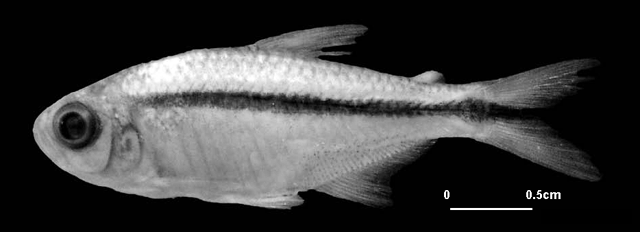| Characidae (Characins; tetras), subfamily: Stethaprioninae |
| 3.13 cm SL (male/unsexed) |
|
benthopelagic; freshwater |
| South America: known only from the type locality in the Tuy River drainage of northern Venezuela. |
|
Dorsal soft rays (total): 11-11; Anal soft rays: 24-25; Vertebrae: 32-32. Distinguished from other species of the genus in having the following characters: inner premaxilla row with 4 teeth; lateral line with 7 pored scales, except in Hyphessobrycon compressus with 7-9; dentary with 6 teeth; maxilla with 2 foramina; mouth subterminal; long bony laminar prolongation on postcleithrum 3 that is 3/4 of the length of that bone; and a continuous dark lateral band from posterior edge of opercle through central caudal-fin rays, except in Hyphessobrycon sovichthys (Ref. 79635).
Description: D ii,9; A iii,21-22; P ii,10-11; V ii,7 (Ref. 79635). |
|
|
Endangered (EN); Date assessed: 12 May 2017 (B1ab(iii)+2ab(iii)) Ref. (130435)
|
| harmless |
|
Konly from the type locality, the Tuy River drainage of northern Venezuela. Its conservation status is probably critical due to influx of domestic sewage that has caused severe eutrophication in the habitat of this species (Ref. 79635). |
Source and more info: www.fishbase.org. For personal, classroom, and other internal use only. Not for publication.

